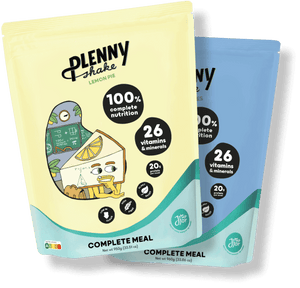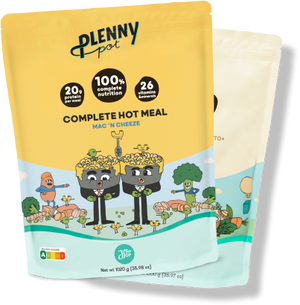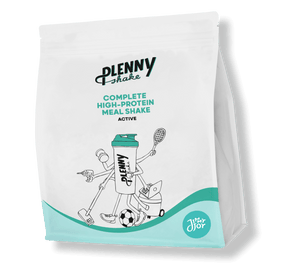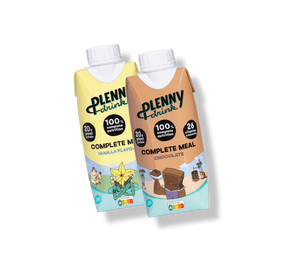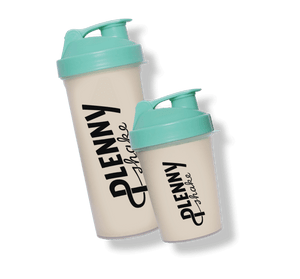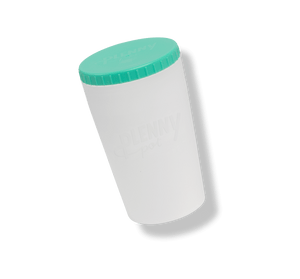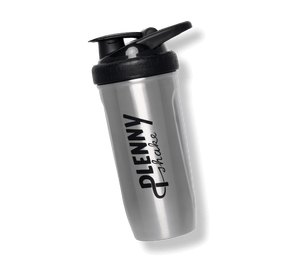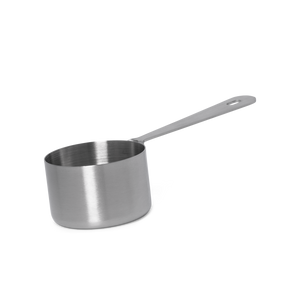
Our mission of creating the healthiest meal scientifically possible never stops! After a lot of hard work, we accomplished this mission by providing you with an even healthier and tastier Plenny Shake Active v3.0.
Jimmy Joy’s provides you with complete meals, using solely plant-based ingredients blended with real fruit to ensure it is as delicious as it is nutritious.
Want to find out more about the changes we made to the formula? This blog will tell you all about it!
TL; DR:
- Improved omega-profile
- Added ahiflower
- Added choline
- Added probiotics
- Improved micronutrient profile
Plenny Shake Active v1.0 vs v3.0 nutritional info
|
Plenny Shake |
v1.0 |
v3.0 |
|
|
Per portion (Vanilla)
|
Per portion |
|
Energy kJ |
1674 |
1674 |
|
Kcal |
400 |
400 |
|
Fat |
15 |
15 |
|
From which saturated |
2,3 |
2,3 |
|
Carbohydrates |
34 |
35 |
|
From which sugars |
3,2 |
3,3 |
|
Fibre |
7,7 |
7,3 |
|
Protein |
27 |
26,3 |
|
Salt |
0,3 |
0,29 |
Our new and improved Plenny Shake 3.0
All about Omega’s
While the Plenny Shake v1.0 got you covered for the essential fatty acids, v3.0 contributes to a bigger goal: having the most desirable omega3/omega 6 ratio as possible. So, what is this ratio and why is it important?
As you might know, omega 3 and omega 6 are groups of polyunsaturated fatty acids that are essential in your diet. While both are important, their abilities are different; omega-3’s are anti-inflammatory while omega-6’s are pro-inflammatory [1,2]. Keeping that in mind, a good balance between both groups is desirable to prevent inflammation. Nevertheless, the common Western diet has an omega 3-6 ratio of 1:16 [3]. This means that there is an excessive consumption of omega-6 fatty acids and a deficient omega-3 intake. Taking this in mind, we gave all our efforts to provide you with a good ratio, which brought us to our newly added and adored ingredient: Ahiflower.
Ahiflower, also referred to as “refined Buglossoides oil”, is a plant-based dietary oil extracted from a non-GMO crop. Ahiflower is the only natural plant source on the market that brings a complex omega profile: it brings an omega 3-6 ratio of approximately 4:1 from the most bioavailable sources wherefore we found it worthwhile to incorporate [4].
As you can imagine, by implementing a new ingredient to our products, some minor tweaks were made in the macronutrient composition.
Macronutrient composition
The carbohydrate content of the Plenny Shake Active v3.0 is increased with 1 gram per portion. This slight increase is nothing to worry about since it is still within the recommended amounts as established by the World Health Organization and considered low in sugar [5,6]! Sweet, right?
The protein content of Plenny Shake Active does now contain 26,3 grams per 400 kcal meal. Even though this is decreased with 0,7 grams per meal, it is still plenty to keep those muscles growing, help your body repair itself and keep you fulfilled throughout the day [7].
Another nutrient reduced minimally is the fibre content of the Plenny Shake Active. But no worries, with 7,3 grams per portion this product is still high in fibre. The high fibre content is perfect to strengthen the effect of one of the extra ingredients we added due to their functional benefits, being probiotics!
Probiotics
Probiotics have the ability to possibly enhance and strengthen our gut microbiome. Because of the high fibre content in Plenny Shakes, they have a symbiotic effect, meaning that probiotics become more resistant and provide a stronger health effect thanks to the fibers which they eat and live from, so basically one ingredient strengthens the other one! [8]
There are different types of probiotic (or live culture) species, from which we decided to add 500 million cultures of Bacillus Coagulans UABc-20 per meal.
Choline
Another ingredient we found worth adding for its functional benefits is choline. The body needs choline to synthesize two major phospholipids vital for cell membranes and to produce acetylcholine, which is an important neurotransmitter for memory, mood, muscle control, and other brain and nervous system functions [9-11]. Choline deficiency can cause muscle damage, liver damage, and non-alcoholic fatty liver disease [9,10,12,13].
We can synthesize choline in our liver ourselves. Nevertheless, these amounts are not sufficient to meet our needs [13]. Obtaining choline from the diet is an easy way to solve that problem! Let us help you with that.
One portion of Plenny Shake Active v3.0 provides 110mg of Choline Hydrogen Tartrate, which is already 28% of the adequate intake of 400mg/day.
Besides the macronutrients, we also dug a little deeper into improving the micronutrient content.
Vitamin E, D
Because of its antioxidant capacity and potential to aid in the preservation of our products, vitamin E was increased. Vitamin D is slightly increased to counteract the possible absence of sunlight one might have. The main activator for the production and uptake of this vitamin is the exposure to sunlight [14–16].
Vitamin B12
Our latest findings on the absorption rate of vitamin B12 made us more curious and after researching further we’ve found out that there can be a saturation in the absorption mechanism of the vitamin. In other words: the absorption efficiency of B12 is lower when high B12 content is higher [17].
This is why we decided to lower the amounts added but of course, making sure that the daily needs and requirements are met [18-22]. In persons with normal absorption, an intake of 4–7 µg of vitamin B12 a day is associated with an adequate vitamin B12 status [23].
Reviews from EFSA conclude that supplements available on the market usually contain dosages between 1-5 µg [24]. An appropriate overdosing based on the bioavailability of different vitamin forms is 2-4 times more than the established adequate intake (which is 4µg for B12) without exceeding any upper limits if established.
The National Centre for Biotechnology Information states that cyanocobalamin losses in urine have been observed to be 3 times higher than that of methylcobalamin. Although absorption in the blood of both B12 forms was similar, it was found that methylcobalamin supplementation caused 13% more cobalamin to be stored in the liver than did cyanocobalamin supplementation [24-26].
We use cyanocobalamin because of being the only non-animal form of this vitamin available for the application we need, and taking into account the previous, at 4 times higher than the daily recommended intakes.
Per portion:
|
|
v1.0 |
v3.0 |
|
Vitamin A |
160 µg |
160 µg |
|
Vitamin D |
3.0 µg |
5.0 µg |
|
Vitamin E |
2,4 mg |
4.0 mg |
|
Vitamin K |
16 µg |
16 µg |
|
Vitamin C |
40 mg |
30 mg |
|
Thiamin |
0.2 mg |
0.4 mg |
|
Riboflavin |
0.3 mg |
0.3 mg |
|
Niacin |
3,6 mg |
3.6 mg |
|
Vitamin B6 |
0.3 mg |
0.4 mg |
|
Folic Acid |
60 µg |
60 µg |
|
Vitamin B12 |
28 µg |
3.2 µg |
|
Biotin |
10 µg |
10 µg |
|
Pantothenic acid |
1.2 mg |
1.2 mg |
|
Potassium |
400 mg |
400 mg |
|
Chloride |
160 mg |
279 mg |
|
Calcium |
185 mg |
185 mg |
|
Phosphorus |
140 mg |
140 mg |
|
Magnesium |
75 mg |
75 mg |
|
Iron |
3,2 mg |
3.2 mg |
|
Zinc |
2.0 mg |
2.0 mg |
|
Copper |
0.2 mg |
0.4 mg |
|
Manganese |
0.4 mg |
1.0 mg |
|
Selenium |
11 µg |
18µg |
|
Chromium |
8 µg |
8 µg |
|
Molybdenum |
13 µg |
13 µg |
|
Iodide |
30 µg |
30 µg |
Sources
- DiNicolantonio JJ, O’Keefe JH. Importance of maintaining a low omega–6/omega–3 ratio for reducing inflammation. Open Heart [Internet]. 2018 Nov 26 [cited 2020 Aug 28];5(2). Available from: https://www.ncbi.nlm.nih.gov/pmc/articles/PMC6269634/
- Balić A, Vlašić D, Žužul K, Marinović B, Bukvić Mokos Z. Omega-3 Versus Omega-6 Polyunsaturated Fatty Acids in the Prevention and Treatment of Inflammatory Skin Diseases. Int J Mol Sci [Internet]. 2020 Jan 23 [cited 2020 Aug 28];21(3). Available from: https://www.ncbi.nlm.nih.gov/pmc/articles/PMC7037798/
- Simopoulos AP. The importance of the ratio of omega-6/omega-3 essential fatty acids. Biomed Pharmacother Biomedecine Pharmacother. 2002 Oct;56(8):365–79.
- Cumberford G, Hebard A. Ahiflower oil: A novel non-GM plant-based omega-3+6 source. Lipid Technol. 2015;27(9):207–10.
- Slavin J, Carlson J. Carbohydrates1. Adv Nutr. 2014 Nov 3;5(6):760–1.
- Medicine I of. Dietary Reference Intakes for Energy, Carbohydrate, Fiber, Fat, Fatty Acids, Cholesterol, Protein, and Amino Acids [Internet]. 2002 [cited 2020 Apr 9]. Available from: https://www.nap.edu/catalog/10490/dietary-reference-intakes-for-energy-carbohydrate-fiber-fat-fatty-acids-cholesterol-protein-and-amino-acids
- WHO | Protein and amino acid requirements in human nutrition [Internet]. WHO. World Health Organization; [cited 2020 Apr 7]. Available from: http://www.who.int/nutrition/publications/nutrientrequirements/WHO_TRS_935/en/
- Holscher H. D. (2017). Dietary fiber and prebiotics and the gastrointestinal microbiota. Gut microbes, 8(2), 172–184. https://doi.org/10.1080/19490976.2017.1290756
- Zeisel SH, Corbin KD. Choline. In: Erdman JW, Macdonald IA, Zeisel SH, eds. Present Knowledge in Nutrition. 10th ed. Washington, DC: Wiley-Blackwell; 2012:405-18.
- Institute of Medicine. Food and Nutrition Board. Dietary Reference Intakes: Thiamin, Riboflavin, Niacin, Vitamin B6, Folate, Vitamin B12, Pantothenic Acid, Biotin, and Choline. Washington, DC: National Academy Press; 1998.
- Zeisel SH. Choline. In: Coates PM, Betz JM, Blackman MR, et al., eds. Encyclopedia of Dietary Supplements. 2nd ed. London and New York: Informa Healthcare; 2010:136-43
- Zeisel SH. Choline. In: Ross AC, Caballero B, Cousins RJ, Tucker KL, Ziegler TR, eds. Modern Nutrition in Health and Disease. 11th ed. Baltimore, MD: Lippincott Williams & Wilkins; 2014:416-26.
- Corbin KD, Zeisel SH. Choline metabolism provides novel insights into nonalcoholic fatty liver disease and its progression. Curr Opin Gastroenterol 2012;28:159-65. [PubMed abstract]
- Boston 677 Huntington Avenue, Ma 02115 +1495‑1000. Vitamin E [Internet]. The Nutrition Source. 2012 [cited 2020 Apr 18]. Available from: https://www.hsph.harvard.edu/nutritionsource/vitamin-e/
- Aranow C. Vitamin D and the Immune System. J Investig Med Off Publ Am Fed Clin Res. 2011 Aug;59(6):881–6.
- Hughes, R. (2021, June 11). Everything you Need to Know about Vitamin D [New Research in 2021] - Intelligent Labs. Intelligent Labs UK. https://uk.intelligentlabs.org/new-guidelines-on-vitamin-d-from-public-health-england/
- Adams, J. F., Ross, S. K., Mervyn, L., Boddy, K., & King, P. (1971). Absorption of cyanocobalamin, coenzyme B 12 , methylcobalamin, and hydroxocobalamin at different dose levels. Scandinavian journal of gastroenterology, 6(3), 249–252. https://doi.org/10.3109/00365527109180702
- Rizzo, G.; Laganà, A.S.; Rapisarda, A.M.C.; La Ferrera, G.M.G.; Buscema, M.; Rossetti, P.; Nigro, A.; Muscia, V.; Valenti, G.; Sapia, F.; Sarpietro, G.; Zigarelli, M.; Vitale, S.G. Vitamin B12 among Vegetarians: Status, Assessment and Supplementation. Nutrients 2016, 8, 767.
- Institute of Medicine. 1998. Dietary Reference Intakes for Thiamin, Riboflavin, Niacin, Vitamin B6, Folate, Vitamin B12, Pantothenic Acid, Biotin, and Choline. Washington, DC: The National Academies Press. doi: 10.17226/6015. https://www.nap.edu/read/6015/chapter/11#309
- Scott JM. Bioavailability of vitamin B12. Eur J Clin Nutr 51(Suppl 1): S49–S53, 1997.
- Bor, Mustafa & Castel-Roberts, Kristina & Kauwell, Gail & Stabler, Sally & Allen, Robert & Maneval, David & Bailey, Lynn & Nexø, Ebba. (2010). Daily intake of 4 to 7 g dietary vitamin B-12 is associated with steady concentrations of vitamin B-12-related biomarkers in a healthy young population. The American journal of clinical nutrition. 91. 571-7. 10.3945/ajcn.2009.28082.
- Watanabe, F. (2007). Vitamin B12 Sources and Bioavailability. Experimental Biology And Medicine, 232(10), 1266-1274. https://doi.org/10.3181/0703-mr-67
- Bor MV, von Castel-Roberts KM, Kauwell GP, et al. Daily intake of 4 to 7 microg dietary vitamin B-12 is associated with steady concentrations of vitamin B-12-related biomarkers in a healthy young population. Am J Clin Nutr. 2010;91(3):571-577. doi:10.3945/ajcn.2009.28082
- European Food Safety Authority. Tolerable upper intake levels for vitamins and minerals. Scientific Committee on Food Scientific Panel on Dietetic Products, Nutrition and Allergies. 2006 http://www.efsa.europa.eu/sites/default/files/assets/ndatolerableuil.pdf
- Adams, J. F., Ross, S. K., Mervyn, L., Boddy, K., & King, P. (1971). Absorption of Cyanocobalamin, Coenzyme B12, Methylcobalamin, and Hydroxocobalamin at Different Dose Levels. Scandinavian Journal of Gastroenterology, 6(3), 249–252.
- Carmel, R. (2008). How I treat cobalamin (vitamin B12) deficiency. Blood, 112(6), 2214–2221. https://doi.org/10.1182/blood-2008-03-040253



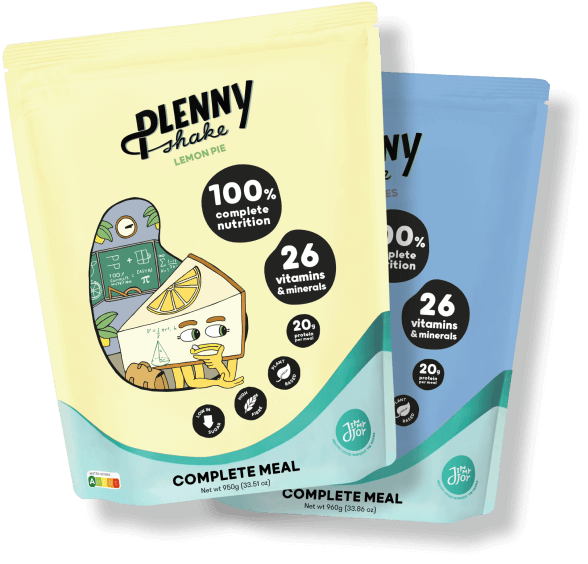



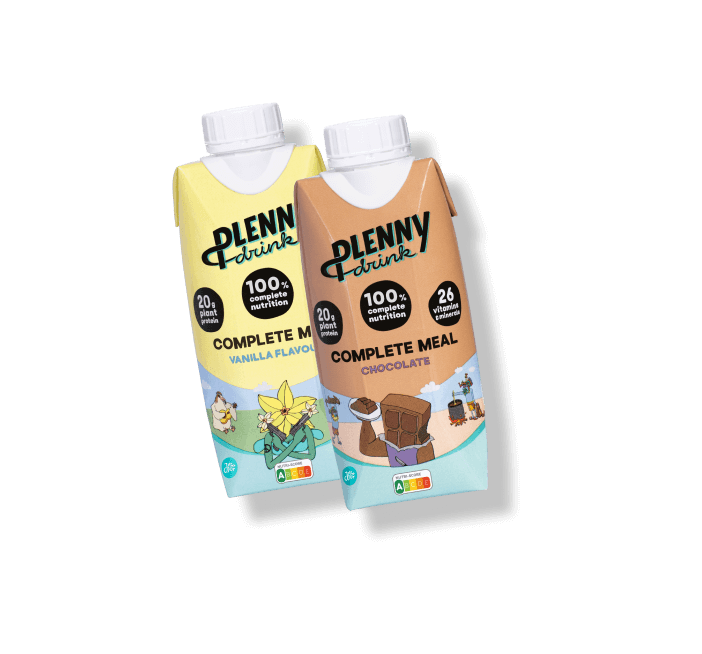












 Product added to cart
Product added to cart
